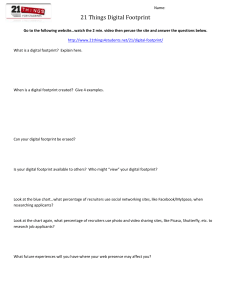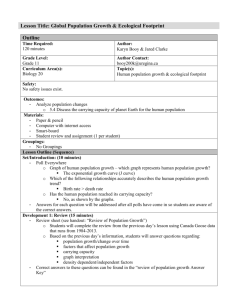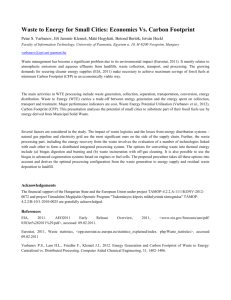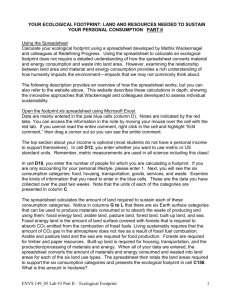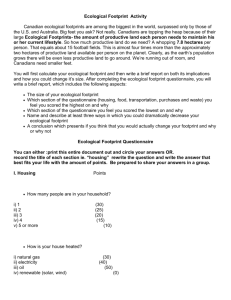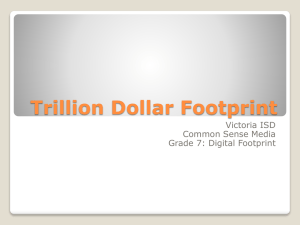Climate Change, Sustainable Living, Watershed Stewardship, Earth
advertisement
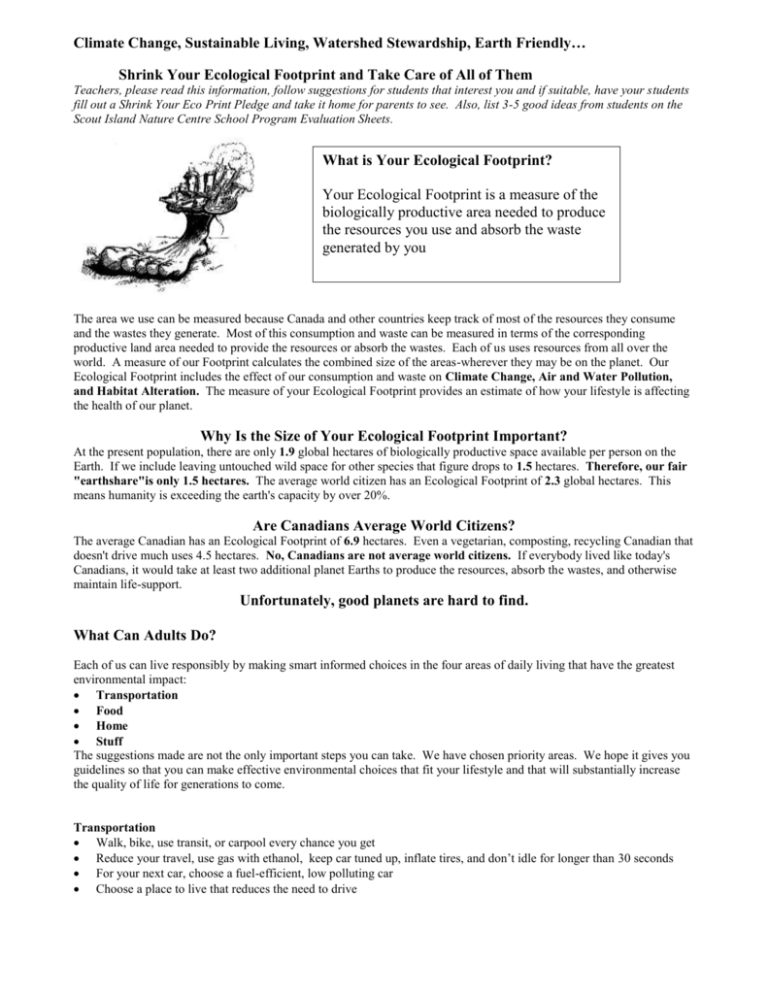
Climate Change, Sustainable Living, Watershed Stewardship, Earth Friendly… Shrink Your Ecological Footprint and Take Care of All of Them Teachers, please read this information, follow suggestions for students that interest you and if suitable, have your students fill out a Shrink Your Eco Print Pledge and take it home for parents to see. Also, list 3-5 good ideas from students on the Scout Island Nature Centre School Program Evaluation Sheets. What is Your Ecological Footprint? Your Ecological Footprint is a measure of the biologically productive area needed to produce the resources you use and absorb the waste generated by you The area we use can be measured because Canada and other countries keep track of most of the resources they consume and the wastes they generate. Most of this consumption and waste can be measured in terms of the corresponding productive land area needed to provide the resources or absorb the wastes. Each of us uses resources from all over the world. A measure of our Footprint calculates the combined size of the areas-wherever they may be on the planet. Our Ecological Footprint includes the effect of our consumption and waste on Climate Change, Air and Water Pollution, and Habitat Alteration. The measure of your Ecological Footprint provides an estimate of how your lifestyle is affecting the health of our planet. Why Is the Size of Your Ecological Footprint Important? At the present population, there are only 1.9 global hectares of biologically productive space available per person on the Earth. If we include leaving untouched wild space for other species that figure drops to 1.5 hectares. Therefore, our fair "earthshare"is only 1.5 hectares. The average world citizen has an Ecological Footprint of 2.3 global hectares. This means humanity is exceeding the earth's capacity by over 20%. Are Canadians Average World Citizens? The average Canadian has an Ecological Footprint of 6.9 hectares. Even a vegetarian, composting, recycling Canadian that doesn't drive much uses 4.5 hectares. No, Canadians are not average world citizens. If everybody lived like today's Canadians, it would take at least two additional planet Earths to produce the resources, absorb the wastes, and otherwise maintain life-support. Unfortunately, good planets are hard to find. What Can Adults Do? Each of us can live responsibly by making smart informed choices in the four areas of daily living that have the greatest environmental impact: Transportation Food Home Stuff The suggestions made are not the only important steps you can take. We have chosen priority areas. We hope it gives you guidelines so that you can make effective environmental choices that fit your lifestyle and that will substantially increase the quality of life for generations to come. Transportation Walk, bike, use transit, or carpool every chance you get Reduce your travel, use gas with ethanol, keep car tuned up, inflate tires, and don’t idle for longer than 30 seconds For your next car, choose a fuel-efficient, low polluting car Choose a place to live that reduces the need to drive Food Buy food as close to where you live as possible or grow your own Buy certified organic products Eat less meat and choose organic or grass fed if possible Less processed food, less packaging—good for you and the earth For More Information Visit Scout Island Nature Centre 398 8532 In the Home Find ways to reduce your home heating and hot water (check Power Smart ideas put out by BC Hydro) Install efficient lighting, appliances, and electronic equipment. Turn them off when they are not in use. Dry your clothes on a line, use a microwave when you can, wash the dishes by hand Choose an energy-efficient home or make yours efficient Replace chemical pesticides on your lawn and garden with non toxic alternatives Reduce use of hazardous cleaners and paints Avoid use of gasoline-powered yard equipment Stuff—Understand the real Cost --www.storyofstuff.com Reduce--Think about what you want. Do you need it or just want it?Wait a week, if you still want it, research the product (the total cost of buying it) Reuse--Buy items that are used or made from recycled products. Donate what you don't want to someone who does want it. Recycle--Only when the item can not be used again. Choose more earth friendly recreational activities--skiing, hiking, canoeing, baseball, birding… Helping Your Students to Shrink Their Footprints 1. 2. 3. Work together as a class to reduce the class footprint -reuse paper both sides before your recycle it -turn lights and computer off when not in use -think of ways to reuse items so new things don’t have to be bought Older students can work at changing school procedures -stop selling junk food in junk containers to fund raise -give rewards to students and teachers who walk or ride their bike to school -stop requiring non essential school supplies -I bet the students can think of even more ideas Encourage students to make individual small footprint choices -discuss and practice garbage less lunches -help them decide on low footprint school supplies-take care of them so they can be reused -talk about walking, bike riding, and other fun activities that have a low footprint -design things they can do at home to help their parents make low footprint choices -Help them understand where their need for more stuff is driven by advertisement etc. Goal—Small Footprint Choices become automatic and pleasurable We can not solve the problems that we have created with the same thinking that created them Albert Einstein Websites of Interest Measure your own footprint www.mec.ca and look for footprint Learn about the science behind priority choices www.davidsuzuki.org -Nature Challenge Information for kids www.ecovoyageurs.com Climate change information www.livesmartbc.ca and www.pembina.org Stewardship Centre www.stewardshipcentre.org/ http://www.salmonopolis.ca/ Lots of interesting information Watershed game on line. Making choices and seeing the effects. http://www.bellmuseum.org/distancelearning/watershed/watershed2.html


